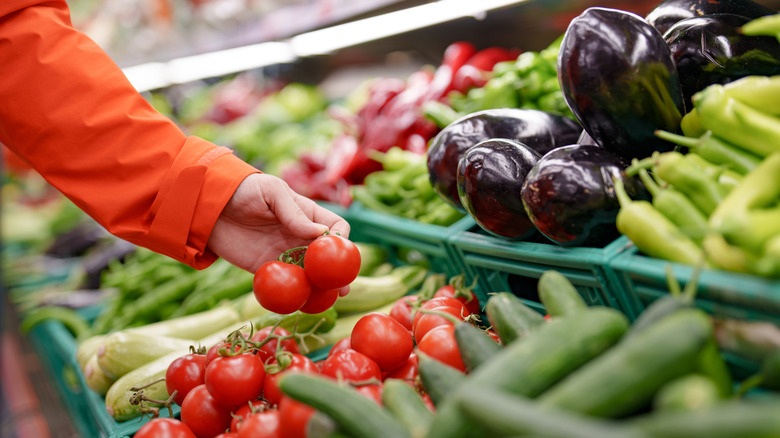One Simple Tip Will Have You Grocery Shopping Like A Master
Discovering that food has gone bad in your fridge is a serious disappointment, especially when you brought it home just a few days earlier. In order to avoid this travesty, you might have to do a bit more work than simply checking a product's expiration date. If you have ever noticed that the "best by" dates seem to be much further away the further back you search on the shelf of a grocery store, you aren't imagining things — there is a reason that grocery stores stock the fresher products behind older ones.
To ensure that perishable food doesn't spoil on shelves, most grocery stores abide by the "First in, first out," or FIFO, method. This practice is a not-so-secret supermarket strategy that stores will use in order to keep their stock from going bad before it is bought by loading in fresh new stock behind products that have already been displayed and need to be sold before their expiration date. But savvy grocery store shoppers who know this method will often grab fruit from the bottom of the pyramid and cheese from the back of the shelf where they know the store's fresh new products are hiding. If you want to bring home perishables that won't grow mold or spoil in just a few days, consider pulling them from the back of a grocery store shelf instead of the front.
Ensure you have the freshest food possible by pulling from the back
You may have to dig a bit to find fresh produce at the grocery store due to the first in, first out method. According to the Institute for Agriculture and Trade Policy, this system is "perhaps the most important thing you can do to ensure high quality products and success." FIFO consists of grocery store employees removing current stock from the display, loading in the new, fresh product on the bottom of a display or back of a shelf, then placing older stock with a sooner expiration date to the front of shelves where it will likely be purchased before spoiling. This method of stocking shelves is an attempt at eliminating unnecessary food waste and allows grocery stores to maximize their product's shelf life even when new, fresh products arrive.
With this understanding, many shoppers are actually able to hack the system and grab the freshest possible products simply by reaching toward the back or bottom of the display. All departments abide by this rule to a certain extent, but it is especially true for perishable foods such as dairy products, fruits and vegetables, and even flowers. If you are hoping to keep your milk lasting as long as possible in your fridge, you may need to go elbow-deep in the dairy aisle.
Grab products from the back of the shelf to avoid unnecessary germs from other shoppers
Expiration dates and extended shelf life are not the only reasons that this grocery shopping hack is an essential practice. Non-perishables like canned goods, boxed cereals, and most products that can be comfortably stored in the pantry may not place as much importance on stocking via the first in, first out method. This is because freshness and expiration dates are not as much of a timely concern for most shoppers, nor do these products expire as quickly if not purchased right away. However, the products displayed up front have likely been handled by more than just you and the employees stocking shelves. Grabbing these products from the back of the shelf may limit the amount of contagions you come into contact with. Shoppers will often touch products that they end up placing back on the front of shelves if they decide against purchasing, not to mention the possibility of being squeezed, poked, sneezed on, and moved around while searching for the perfect one. To avoid products that have come into contact with an excess number of guests, try grabbing products from a few rows back. And try not to be rude in the grocery store by handling products you don't intend to purchase.


